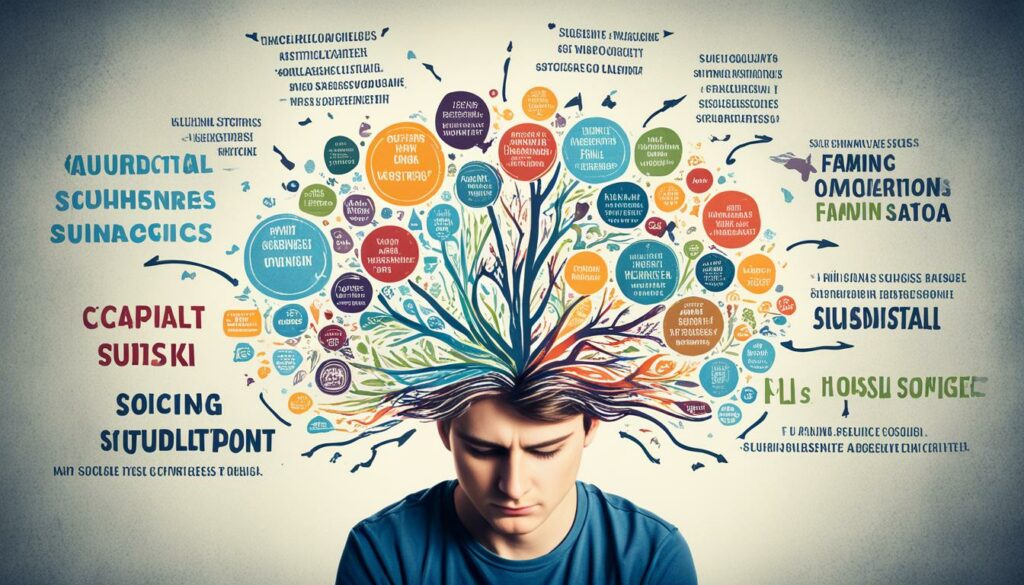Understanding Why Teens Commit Suicide
Teen suicide is a pressing issue with significant consequences. Suicide is the third leading cause of death among young people aged 15 to 24. Boys are four times more likely to die from suicide than girls, although girls are more likely to attempt suicide. Guns are used in more than half of youth suicides. The teen years are a stressful time, filled with major changes and intense emotions. These changes, combined with other factors such as family issues, school problems, and mental health conditions, can contribute to suicidal behavior in teens.
Key Takeaways:
- Teen suicide is the third leading cause of death among young people aged 15 to 24.
- Boys are four times more likely to die from suicide, but girls are more likely to attempt suicide.
- Guns are used in more than half of youth suicides.
- The teen years are a stressful time, filled with major changes and intense emotions.
- Family issues, school problems, and mental health conditions can contribute to suicidal behavior in teens.
What Causes a Teen to Attempt Suicide?

Teens may attempt suicide due to a combination of factors. Normal developmental changes during adolescence, along with challenging life events such as family changes, friendship issues, and academic struggles, can be overwhelming for some teens. These problems may seem insurmountable and suicide may appear as a solution. Risk factors for teen suicide can include mental health conditions, impulsive behaviors, family history of suicide, exposure to suicidal behavior in others, and access to guns. Early recognition and intervention are crucial in preventing suicide attempts.
Adolescent Suicide Risk Factors
Understanding the risk factors associated with adolescent suicide is essential for effective prevention and intervention strategies. The following factors can increase the likelihood of a teen attempting suicide:
| Risk Factors | Description |
|---|---|
| Mental Health Conditions | Conditions such as depression, anxiety, bipolar disorder, and substance abuse can contribute to suicidal thoughts and behaviors in teenagers. |
| Impulsive Behaviors | Teens who engage in impulsive behaviors, such as self-harm, risky sexual behaviors, or substance abuse, may be at a higher risk for suicide. |
| Family History of Suicide | Having a family member who has died by suicide can increase the risk of suicidal ideation and attempts in teenagers. |
| Exposure to Suicidal Behavior | Being exposed to the suicide of a friend, classmate, or family member can have a significant impact on a teen’s mental well-being and increase suicide risk. |
| Access to Guns | Easy access to firearms in the home has been linked to higher rates of completed suicides among teenagers. |
Identifying these risk factors and addressing them promptly is crucial in preventing suicidal behavior among adolescents. Early intervention and appropriate support can make a significant difference in saving young lives.
Warning Signs of Teen Suicide

Recognizing the warning signs of teen suicide is crucial in preventing tragedy. These signs often overlap with symptoms of teen depression, which is closely tied to suicidal thoughts and behaviors. By understanding and being aware of these warning signs, you can take immediate action and provide the necessary support.
Common Warning Signs
- Changes in eating and sleeping habits
- Loss of interest in activities once enjoyed
- Withdrawal from friends and family
- Engaging in risky behaviors
- Substance abuse
- Neglecting personal appearance
- Obsession with death
It’s important to note that not all teenagers who display these signs are necessarily suicidal. However, these warning signs should not be ignored and warrant further investigation and support. Trust your instincts and seek assistance if you suspect a teenager may be in danger.
Verbal Signs and Gestures
In addition to behavioral changes, paying attention to verbal statements and gestures can provide important clues.
“I just want to end it all.”
“I wish I were dead.”
“Everyone would be better off without me.”
These explicit expressions of suicidal thoughts or intentions should always be taken seriously. Immediate action is necessary to ensure the individual’s safety and access to appropriate help.
Diagnosing and Treating Suicidal Behavior in Teens

When a teen expresses thoughts of suicide, it is crucial to take those statements seriously and seek a professional evaluation. A comprehensive assessment should include a physical checkup to rule out any immediate health concerns, followed by a thorough mental health evaluation. Treatment for suicidal behavior may involve individual therapy, family therapy, and, in severe cases, a hospital stay to ensure the safety of the teen. The goal of treatment is to stabilize the teen’s condition and provide support to address underlying issues.
| Diagnosing Suicidal Behavior in Teens | Treating Suicidal Behavior in Teens |
|---|---|
|
|
When diagnosing suicidal behavior in teens, healthcare professionals conduct a thorough evaluation to understand the underlying factors contributing to their distress. This assessment involves a physical checkup to rule out any immediate health concerns and a detailed mental health evaluation. The mental health evaluation includes an assessment of the teen’s emotional state, mental health history, and an exploration of potential suicide risk factors and warning signs. Screening for mental health conditions and consideration of family history of suicide further inform the diagnostic process.
Treating suicidal behavior in teens requires a comprehensive approach that addresses both the immediate safety concerns and the underlying issues contributing to their distress. Individual therapy sessions provide a supportive and confidential space for the teen to explore their thoughts and feelings and develop coping mechanisms. Family therapy is crucial in improving communication within the family unit and creating a supportive environment for the teen’s recovery. In some cases, psychiatric medication may be prescribed to manage underlying mental health conditions. For severe cases where safety is a concern, hospitalization may be necessary to provide intensive treatment and ensure the teen’s well-being.
Collaboration with healthcare professionals, including psychiatrists and psychologists, ensures comprehensive and holistic care for the teen. Through a combination of therapy, medication, and ongoing support, the goal of treatment is to stabilize the teen’s condition, alleviate their distress, and equip them with the necessary tools to cope with their emotions and challenges.
Preventing Teen Suicide

Preventing teen suicide requires a multi-faceted approach that involves understanding the risk factors and implementing effective strategies. Open communication between parents, caregivers, and teens plays a vital role in providing the necessary support and fostering a safe environment.
To prevent teen suicide, it is important to:
- Secure medications and firearms: Keep potentially harmful items securely locked away to reduce access and minimize the risk of impulsive actions.
- Promptly address mental health and substance use issues: Early intervention is crucial in identifying and managing mental health conditions and substance abuse problems that contribute to suicidal thoughts and behaviors.
- Maintain a supportive and non-judgmental environment: Teens need a safe space where they feel comfortable expressing their emotions and seeking help without fear of judgment or stigma.
- Stay informed about warning signs and risk factors: Educate yourself on the warning signs of teen suicide, such as changes in behavior and withdrawal from activities, as well as the risk factors associated with suicidal thoughts and attempts.
- Encourage help-seeking: Encourage teens to seek help from trusted adults, such as parents, teachers, or mental health professionals, if they or their friends are experiencing suicidal thoughts or behaviors.
“Preventing teen suicide requires a multi-faceted approach that involves understanding the risk factors and implementing effective strategies.”
By taking these preventive measures, we can create a supportive environment where teens feel valued, heard, and understood, reducing the risk of suicide and promoting their overall well-being.
Promoting Mental Health in Teens
Mental health plays a crucial role in preventing teen suicide. By prioritizing mental well-being and implementing strategies to promote positive mental health, we can provide a strong foundation for preventing suicidal thoughts and behaviors.
Some key strategies for promoting mental health in teens include:
- Fostering open conversations: Encourage open and honest discussions about mental health, emotions, and stressors, creating a safe space for teens to express their feelings.
- Building resilience: Teach teens coping mechanisms and resilience-building techniques to help them navigate challenging situations and bounce back from adversity.
- Promoting self-care: Encourage teens to prioritize self-care activities that promote mental and emotional well-being, such as exercise, getting enough sleep, and engaging in hobbies.
- Addressing stigma: Fight against the stigma surrounding mental health by promoting awareness and acceptance, emphasizing that seeking help is a sign of strength, not weakness.
- Providing access to mental health resources: Ensure that teens have access to mental health resources such as counseling services, support groups, and helplines.
“By prioritizing mental well-being and implementing strategies to promote positive mental health, we can provide a strong foundation for preventing suicidal thoughts and behaviors.”
By implementing these strategies and creating a culture that values mental health, we can reduce the risk of teen suicide and create a supportive environment that strengthens the overall well-being of our teens.
Supporting At-Risk Teenagers
Identifying and providing support for at-risk teenagers is crucial in preventing teen suicide. Early intervention and targeted assistance can make a significant difference in their lives.
Key ways to support at-risk teenagers include:
- Creating a safe and trusting environment: Establish a supportive environment where at-risk teenagers feel comfortable talking about their feelings and seeking help without judgment or fear.
- Encouraging professional help: Connect at-risk teenagers with mental health professionals who can provide the necessary interventions and support.
- Building a network of support: Involve trusted adults, such as parents, friends, teachers, and mentors, who can provide additional guidance and support during difficult times.
- Monitoring and supervision: Keep a close eye on at-risk teenagers, particularly during times of heightened distress or after a challenging life event, providing the necessary support and guidance.
- Offering resources and helplines: Provide information about local resources, helplines, and support groups that can offer additional guidance and support to at-risk teenagers.
“Identifying and providing support for at-risk teenagers is crucial in preventing teen suicide.”
By implementing these support strategies, we can create a safety net for at-risk teenagers, offering them the care and assistance they need to overcome their challenges and reduce the risk of suicide.
The Complex Factors Behind Teen Suicide

Understanding the factors contributing to teen suicide is crucial in developing effective prevention strategies. It is not a simple issue with a single cause, but rather a combination of various factors that culminate in this tragic outcome. These factors encompass a range of influences, including societal pressures, family issues, and individual challenges.
Societal Pressures on Teenagers
Societal pressures play a significant role in shaping the experiences and perceptions of teenagers. The unrealistic expectations placed on young individuals to succeed academically, socially, and professionally can be overwhelming. The constant pressure to fit societal standards and meet perceived benchmarks can lead to feelings of inadequacy, stress, and a sense of hopelessness.
Moreover, the impact of media on teenagers is undeniable. The media often portrays an idealized version of success and happiness, creating unrealistic standards that young individuals feel compelled to meet. The constant exposure to curated images and stories can distort their perceptions of reality and fuel insecurities and discontent.
Impacts of Family Issues on Teens
Family issues can also contribute to the complex factors behind teen suicide. Difficulties within the family dynamic, such as high conflict, parental divorce, loss of a loved one, or emotional neglect, can significantly impact a teenager’s mental and emotional well-being. These factors can lead to a sense of instability, loneliness, and a lack of support, which can amplify the risk of suicidal thoughts and behaviors.
Childhood trauma, attachment issues in early childhood, and developmental delays and learning disabilities are additional factors that can compound the challenges faced by teenagers. These issues can contribute to a sense of disconnection, low self-esteem, and difficulties in coping with stress, which can further contribute to the risk of suicidal behavior.
Understanding the interplay of societal pressures and family issues is essential in addressing the complex factors behind teen suicide and developing effective prevention strategies.
Additional Contributing Factors
In addition to societal pressures and family issues, a range of other factors can contribute to the risk of teen suicide. Mental health issues, such as depression, anxiety disorders, bipolar disorder, and substance abuse, often coexist with suicidal ideation. These conditions can impair a teenager’s ability to cope with challenges, exacerbating their vulnerability to suicidal behavior.
It is important to recognize that the factors contributing to teen suicide are multifaceted and interconnected. The combination of societal pressures, family issues, and individual challenges can create a perfect storm for vulnerability. By understanding these complex factors, we can work towards creating a supportive environment that fosters resilience, mental well-being, and ultimately, the prevention of teen suicide.
The Role of the Teen Brain in Suicidal Behavior
During adolescence, the teen brain is going through a crucial development phase, and this has significant implications for understanding suicidal behavior in teenagers. One key area of the brain that is still maturing during this time is the prefrontal cortex, which is responsible for logical reasoning and decision-making.
The underdevelopment of the prefrontal cortex in teens can contribute to impulsive behavior and poor decision-making skills. This makes teenagers particularly vulnerable to engaging in risky behaviors, including suicidal thoughts and actions. Their ability to consider the long-term consequences of their actions may be compromised, leading to impulsive choices.
One way to understand the interaction between emotions and rational thinking in teenagers is through the concept of the “upstairs and downstairs brain.” The upstairs brain refers to the prefrontal cortex, involved in higher-order thinking, while the downstairs brain refers to the emotional and impulsive region, known as the amygdala. In teenagers, the downstairs brain often dominates, overpowering the upstairs brain, leading to emotional reactions that override logical reasoning.
This imbalance between the emotional and rational aspects of the brain can be particularly challenging for teenagers when faced with difficult situations, such as challenges, rejections, or conflicts. Their emotional response may override their logical thinking, making them more susceptible to making impulsive decisions, including contemplating or engaging in suicidal behavior.
Furthermore, the teen brain can be negatively impacted by various factors, such as stress, depression, and abuse. These experiences can cause damage to brain cells and further increase the risk of suicide. It is essential to recognize the impact of these factors on the developing brain and provide appropriate support and interventions to reduce the risk of suicidal behavior.
Understanding the role of the teen brain in suicidal behavior is crucial for implementing effective prevention strategies. By addressing the specific vulnerabilities and challenges associated with brain development during adolescence, we can provide the necessary support and resources to help teenagers navigate their emotions and make healthier choices.
The Cultural Impact on Teen Suicide
Our culture plays a significant role in influencing teen suicide rates. The constant exposure to societal messaging and media can have a profound impact on the mental well-being of teenagers. Cultural influences, such as the promotion of instant gratification, aggression, and desensitization to violence, can contribute to the vulnerability of young individuals.
The media often sets unrealistic standards and emphasizes entitlement, which can lead to feelings of anger, disappointment, and a sense of hopelessness among teens. This pressure to meet societal expectations can be overwhelming and contribute to the risk of suicide.
“The emphasis on material possessions and external validation, perpetuated by our culture, can build a sense of worthlessness and inadequacy in teenagers.”
Additionally, the constant exposure to negative news and violence through various media channels can distort teens’ perspectives and make them more susceptible to suicidal thoughts and behaviors. The images and messages conveyed by the media can subconsciously influence their perceptions and contribute to a distorted view of the world.
To mitigate these cultural influences and reduce the risk of teen suicide, it is essential to promote a culture of empathy, resilience, and realistic expectations. By fostering an environment that values emotional well-being and encourages open communication, we can counteract the negative impact of societal messaging and media.
| Cultural Factors | Impact on Teen Suicide |
|---|---|
| Instant Gratification | Increases impulsive behaviors and decreases coping skills |
| Aggression | Normalizes violence and contributes to a hostile environment |
| Desensitization to Violence | Reduces empathy and fosters a lack of concern for others |
| Unrealistic Standards | Creates feelings of inadequacy and perpetuates a sense of failure |
| Negative News Exposure | Distorts perceptions and contributes to a pessimistic outlook |
Conclusion
Preventing teen suicide and promoting mental health in teens is a crucial endeavor that requires a comprehensive approach. By understanding the risk factors, recognizing the warning signs, and addressing societal influences, we can better protect our young people from the tragedy of suicide.
One of the key strategies in teen suicide prevention is promoting mental health. Open communication and early intervention play a vital role in recognizing and addressing issues that may contribute to suicidal behavior. Parents, caregivers, educators, and healthcare professionals must work together to create a supportive environment where teens feel safe to express their emotions and seek help when needed.
Furthermore, it is essential to provide resources and support for at-risk teenagers. From therapy and counseling services to helplines and online support groups, there are various avenues available for teenagers in crisis. By offering these resources and actively promoting their availability, we can ensure that struggling teens have access to the help they need.
Reducing the incidence of teen suicide requires a collective effort from all members of society. By coming together and prioritizing the mental well-being of our young people, we can create a culture that values empathy, resilience, and realistic expectations. Together, let us strive to prevent teen suicide, promote understanding of suicidal behavior, and support the mental health of our teens.
FAQ
Why do teens commit suicide?
Teens may commit suicide due to a combination of factors, including developmental changes during adolescence, major life events, mental health conditions, impulsive behaviors, family history of suicide, exposure to suicidal behavior, and access to guns.
What are the risk factors for teen suicide?
Risk factors for teen suicide can include mental health conditions, impulsive behaviors, family history of suicide, exposure to suicidal behavior in others, and access to guns.
What are the warning signs of teen suicide?
Warning signs of teen suicide can include changes in eating and sleeping habits, loss of interest in activities, withdrawal from friends and family, risky behaviors, substance abuse, neglecting personal appearance, obsession with death, and verbal statements or gestures indicating suicidal thoughts or intentions.
How is suicidal behavior in teens diagnosed and treated?
Suicidal behavior in teens is diagnosed through a comprehensive assessment, including a physical checkup and mental health evaluation. Treatment may involve individual therapy, family therapy, and, in severe cases, a hospital stay to ensure safety.
How can teen suicide be prevented?
Teen suicide can be prevented through open communication, securing medications and firearms, addressing mental health and substance use issues, creating a supportive environment, and staying informed about warning signs and risk factors.
What are the complex factors behind teen suicide?
Complex factors contributing to teen suicide can include attachment issues, childhood trauma, developmental delays, learning disabilities, mental health issues, cultural and societal pressures, and the impact of media on perceptions.
What is the role of the teen brain in suicidal behavior?
The underdevelopment of the teen brain, particularly the prefrontal cortex responsible for logic and reasoning, can contribute to impulsive behavior and poor decision-making. Stress, depression, and abuse also impact brain development, increasing the risk of suicide.
How does culture impact teen suicide?
Culture can contribute to teen suicide through the promotion of instant gratification, aggression, and desensitization to violence. Unrealistic expectations and constant exposure to negative news and violence can lead to feelings of anger, disappointment, and hopelessness.
How can we understand and prevent teen suicide?
By recognizing risk factors, warning signs, and societal influences, and promoting mental health, open communication, and early intervention, we can understand and prevent teen suicide, creating a supportive environment for at-risk individuals.







